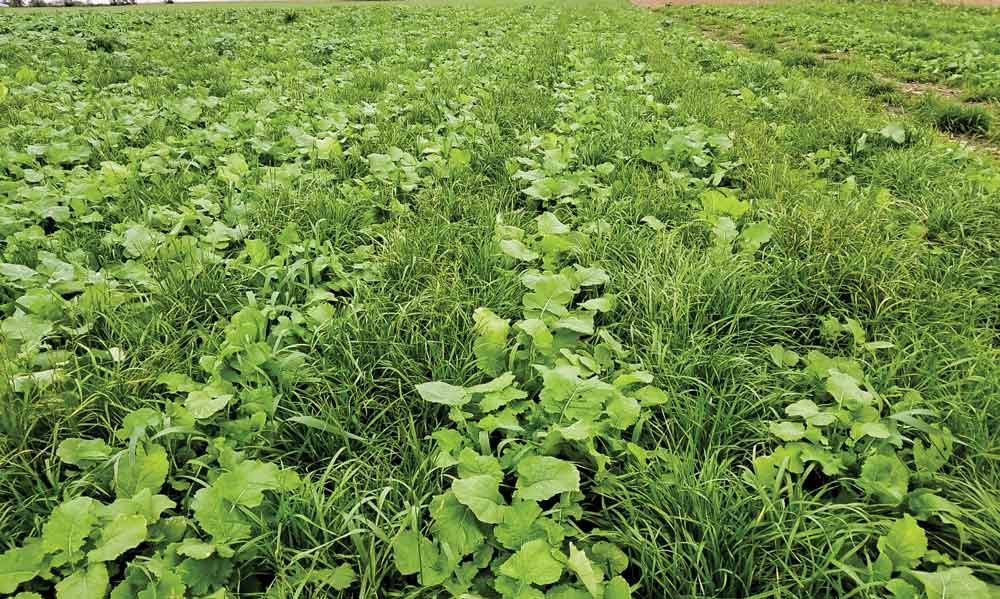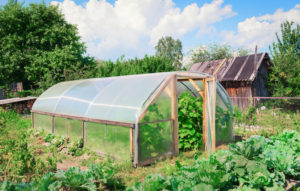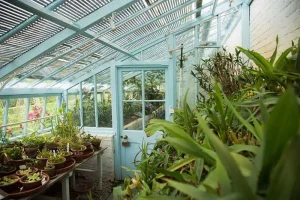Cover crops are a powerful tool for soil enrichment and pest control.
By integrating cover crops into your farming or gardening practices, you can improve soil health, reduce erosion, increase biodiversity, and deter pests naturally.
We will explore the various ways to use cover crops for these benefits, including specific plant recommendations, planting schedules, and best management practices.
Whether you’re a seasoned farmer or just starting out with gardening, there’s something here for everyone looking to enhance their soil and control pests without resorting to harmful chemicals.
So let’s dive in!
Nitrogen Fixation
Legume cover crops like clover and beans have the ability to fix nitrogen from the air into the soil, reducing the need for synthetic fertilizers and improving soil fertility.
This process is made possible through a symbiotic relationship with soil bacteria that live inside the plant’s root nodules.
These bacteria, known as rhizobia, convert nitrogen gas into ammonium ions, which are then absorbed by the plant and made available to other crops.
By incorporating legume cover crops into your farming rotation, you can significantly reduce your reliance on synthetic fertilizers and improve the overall fertility of your soil.
In addition, legume cover crops can help to suppress weeds, improve soil structure, and increase biodiversity, making them an excellent addition to any sustainable agriculture system.
By choosing to grow legume cover crops, you are not only improving the health of your soil, but also contributing to a more sustainable and environmentally-friendly farming practices.
Soil Erosion Control
Cover crops can help to control soil erosion by holding the soil in place and reducing soil loss during heavy rainfall or high winds.
Cover crops are an effective tool in controlling soil erosion, as they hold the soil in place and reduce soil loss during heavy rainfall or high winds.
These crops form a protective blanket over the soil, preventing it from being washed or blown away.
This is especially important in areas prone to heavy rainfall or strong winds, where soil erosion can be a major issue.
By planting cover crops, farmers and gardeners can help to maintain the integrity of their soil, preventing it from being washed or blown away.
This can lead to increased soil fertility, better crop yields, and a healthier ecosystem overall.
Cover crops can help to absorb excess nutrients in the soil, reducing the risk of pollution and maintaining a healthy balance of nutrients in the soil.
By incorporating cover crops into their agricultural or gardening practices, individuals can help to protect their soil from erosion and maintain its fertility for future use.
Weed Suppression
By planting cover crops in the off-season, they can suppress weeds and reduce the need for herbicides.
Planting cover crops during the off-season is an effective way to suppress weeds and reduce the need for herbicides.
Cover crops such as legumes, grasses, and broad-leaved plants compete with weeds for light, water, and nutrients, thereby suppressing their growth.
This can lead to a significant reduction in weed populations, which in turn can reduce the need for herbicides.
In addition, cover crops can provide a natural mulch that shades the soil and prevents weeds from germinating.
By choosing the right cover crop for your specific soil type and climate, you can create a weed-suppressing barrier that lasts throughout the growing season.
For example, legumes such as clover or beans can fix nitrogen in the soil, while grasses like wheat or oats can form a dense mat that prevents weeds from growing.
By incorporating cover crops into your crop rotation, you can improve soil health, increase crop yields, and reduce your reliance on herbicides.
Pest Control
Some cover crops, like buckwheat, can be used as a trap crop to lure pests away from other crops and reduce pest pressure.
Using buckwheat as a trap crop is an effective pest control method that can help reduce pest pressure on other crops.
When planted as a cover crop, buckwheat acts as a decoy for pests, attracting them away from your main crops and into the buckwheat fields.
This gives your other crops a break from pest infestations, allowing them to grow healthy and strong.
The dense canopy of buckwheat provides a habitat for beneficial insects, such as ladybugs and lacewings, which prey on pests, further reducing pest pressure.
By incorporating buckwheat into your crop rotation, you can maintain a healthy and balanced ecosystem, while also improving soil health and fertility.
Soil Health Improvement
Cover crops can improve soil health by increasing organic matter, improving soil structure, and providing habitat for beneficial soil organisms.
Cover crops are a powerful tool for improving soil health.
By integrating cover crops into your farming routine, you can significantly increase the amount of organic matter in your soil.
These crops, such as legumes and grasses, absorb atmospheric carbon dioxide and convert it into organic compounds that enrich the soil.
Cover crops improve soil structure by adding bulk and stability to the soil, making it easier to work with and less prone to erosion.
Furthermore, the diverse array of cover crops provides habitat for beneficial soil organisms, such as earthworms and microorganisms, which play a critical role in breaking down organic matter and making nutrients available to your crops.
By incorporating cover crops into your farming strategy, you can create a more resilient and productive agroecosystem that is better equipped to withstand the challenges of climate change and other environmental stressors.
Disease and Fungus Control
Cover crops can help to control diseases and fungal infections in crops by creating a barrier on the soil surface and reducing the amount of moisture that can harbor pathogens.
By incorporating cover crops into your agricultural management strategy, you can effectively control diseases and fungal infections in your crops.
Cover crops create a physical barrier on the soil surface, preventing the spread of pathogens and reducing the amount of moisture that can harbor harmful organisms.
This barrier function helps to prevent the entry of disease-causing organisms into the soil, while also minimizing the growth of fungal infections.
Moreover, the diversity of cover crops can provide a range of beneficial effects, such as improving soil health, reducing soil erosion, and suppressing weeds, which can also contribute to reducing the risk of disease and fungal infections.
Cover crops can provide a source of organic matter and nutrients, which can help to strengthen the overall health of your crops and make them more resilient to disease.
By implementing cover crops into your farming practice, you can proactively prevent disease and fungal infections, resulting in improved crop yields and a healthier, more sustainable agricultural system.
Improved Soil Biodiversity
Cover crops can increase soil biodiversity by providing habitat for a variety of soil organisms, including beneficial insects and microorganisms.
By incorporating cover crops into their farming practices, growers can significantly improve soil biodiversity.
These plants provide a habitat for a diverse array of soil organisms, including beneficial insects and microorganisms.
For instance, cover crops like legumes can host nitrogen-fixing bacteria, which in turn enhance soil fertility and support the growth of subsequent crops.
Cover crops like winter rye and winter wheat can shelter overwintering insects like bees and butterflies, providing a critical source of food and shelter for these beneficial organisms.
Moreover, cover crops can provide a vital food source for soil microorganisms, such as fungi and protozoa, which play a important role in decomposing organic matter and cycling nutrients through the soil.
By promoting a healthy and diverse soil ecosystem, cover crops can help maintain soil fertility, enhance crop resilience, and promote sustainable agriculture practices.
Biofumigation
Cover crops can suppress pests and diseases by releasing volatile compounds that are toxic to these organisms, a process known as biofumigation.
Biofumigation is a phenomenon that utilizes cover crops to release volatile compounds that are toxic to pests and diseases, providing an eco-friendly solution to agricultural pest management.
Cover crops, such as legumes and cereal crops, have been found to release a variety of volatile compounds, including terpenoids, aldehydes, and phenolic compounds, which are toxic to pests and diseases.
These compounds can be released into the air and soil, providing a natural barrier against pests and diseases.
When applied as a cover crop, these compounds can suppress pests and diseases, reducing the need for synthetic pesticides and improving crop health.
The mechanisms by which cover crops release these volatile compounds are complex and not yet fully understood, but it is thought that the crops may release these compounds in response to environmental factors, such as temperature, humidity, and light.
Some cover crops have been found to harbor beneficial microorganisms, such as bacteria and fungi, which can also contribute to the suppression of pests and diseases.
By incorporating cover crops into their agricultural practices, farmers can take advantage of the biofumigation process, reducing the need for synthetic pesticides and improving crop health and productivity.
Want More? Dive Deeper Here!
Hey there! If you’re the type who loves going down the rabbit hole of information (like we do), you’re in the right spot. We’ve pulled together some cool reads and resources that dive a bit deeper into the stuff we chat about on our site. Whether you’re just killing time or super into the topic, these picks might just be what you’re looking for. Happy reading!






